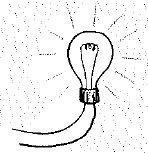
Concept explainers
How could you light a lightbulb that is near, yet not touching, an
Is AC or DC required? Defend your answer.

To explain: the AC or DC is required to lighten the bulb.
Answer to Problem 28A
The AC is required as due to alternating current the voltage induces to lighten the bulb.
Explanation of Solution
Introduction:
The alternating current induces voltage.
AC stands for Alternating current and DC stands for Direct Current. The direct current remains the same has it has no polarity so there will be no change in the magnetic field. The alternating current changes the magnetic field of the electromagnet as a result of which the voltage induces in the wire of the bulb and the light bulb gets lit.
Conclusion:
The alternating current (AC) produces induced voltage and the light bulb gets lit.
Chapter 37 Solutions
Conceptual Physics: The High School Physics Program
Additional Science Textbook Solutions
Human Physiology: An Integrated Approach (8th Edition)
Applications and Investigations in Earth Science (9th Edition)
Chemistry: An Introduction to General, Organic, and Biological Chemistry (13th Edition)
Organic Chemistry (8th Edition)
Campbell Biology in Focus (2nd Edition)
Campbell Biology (11th Edition)
- 10:44 AM Fri Jan 31 O Better endurance Limb end points travel less D Question 2 Take Quiz 1 pt: Two springs are arranged in series, and the whole arrangement is pulled a vertical distance of 2 cm. If the force in Spring A is 10 N, what is the force in Spring B as a result of the displacement? 05N 5 N 0.2 N 10 N O2N Question 3 1 ptsarrow_forwardNo chatgpt pls will upvote Already got wrong chatgptarrow_forwardPlz no chatgpt pls will upvotearrow_forward
- I need correct answer not chatgptarrow_forwardWhat is the resistance (in (2) of a 27.5 m long piece of 17 gauge copper wire having a 1.150 mm diameter? 0.445 ΧΩarrow_forwardFind the ratio of the diameter of silver to iron wire, if they have the same resistance per unit length (as they might in household wiring). d. Ag dFe = 2.47 ×arrow_forward
- Find the ratio of the diameter of silver to iron wire, if they have the same resistance per unit length (as they might in household wiring). d Ag = 2.51 dFe ×arrow_forwardShow that the units 1 v2/Q = 1 W, as implied by the equation P = V²/R. Starting with the equation P = V²/R, we can get an expression for a watt in terms of voltage and resistance. The units for voltage, V, are equivalent to [? v2 v2 A, are equivalent to J/C ✓ X . Therefore, 1 = 1 = 1 A V1 J/s Ω V-A X = 1 W. . The units for resistance, Q, are equivalent to ? The units for current,arrow_forwardPlease solve and answer the question correctly please. Thank you!!arrow_forward
 College PhysicsPhysicsISBN:9781305952300Author:Raymond A. Serway, Chris VuillePublisher:Cengage Learning
College PhysicsPhysicsISBN:9781305952300Author:Raymond A. Serway, Chris VuillePublisher:Cengage Learning University Physics (14th Edition)PhysicsISBN:9780133969290Author:Hugh D. Young, Roger A. FreedmanPublisher:PEARSON
University Physics (14th Edition)PhysicsISBN:9780133969290Author:Hugh D. Young, Roger A. FreedmanPublisher:PEARSON Introduction To Quantum MechanicsPhysicsISBN:9781107189638Author:Griffiths, David J., Schroeter, Darrell F.Publisher:Cambridge University Press
Introduction To Quantum MechanicsPhysicsISBN:9781107189638Author:Griffiths, David J., Schroeter, Darrell F.Publisher:Cambridge University Press Physics for Scientists and EngineersPhysicsISBN:9781337553278Author:Raymond A. Serway, John W. JewettPublisher:Cengage Learning
Physics for Scientists and EngineersPhysicsISBN:9781337553278Author:Raymond A. Serway, John W. JewettPublisher:Cengage Learning Lecture- Tutorials for Introductory AstronomyPhysicsISBN:9780321820464Author:Edward E. Prather, Tim P. Slater, Jeff P. Adams, Gina BrissendenPublisher:Addison-Wesley
Lecture- Tutorials for Introductory AstronomyPhysicsISBN:9780321820464Author:Edward E. Prather, Tim P. Slater, Jeff P. Adams, Gina BrissendenPublisher:Addison-Wesley College Physics: A Strategic Approach (4th Editio...PhysicsISBN:9780134609034Author:Randall D. Knight (Professor Emeritus), Brian Jones, Stuart FieldPublisher:PEARSON
College Physics: A Strategic Approach (4th Editio...PhysicsISBN:9780134609034Author:Randall D. Knight (Professor Emeritus), Brian Jones, Stuart FieldPublisher:PEARSON





